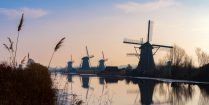Confession – when I first pictured diving in the Netherlands, all I could imagine was cold water and terrible visibility. While the visibility may not have been the greatest thanks to the copious amounts of rain that had been falling in the days leading up to our dive, it took only a single dive in the south of Zeeland to completely change my mind on diving in the Netherlands.


The Dutch province of Zeeland is located in the south-west of the Netherlands just at the border of Belgium. Sitting at the mouth of a large river delta, where several rivers converge and dump themselves into the Atlantic ocean, Zeeland is made up of islands and peninsulas connected by dams, tunnels, and bridges. The name “Zeeland” translates to sea land, a fitting name for the 2,930 square kilometers of province of which almost 1,140 square kilometers is water.
Given Zeeland’s predominantly “watery” nature, beach lovers and scuba divers alike make their way to this maritime province to stay salty in the summer months.
From much of the dive research I had been doing to date, it didn’t take me long to determine that the best place to get our fins wet in the Netherlands was in Zeeland.

With Grevelingenmeer and Oosterschelde National Park in their backyard, Duikcentrum De Witte Boulevard a dive shop located in the small town of Renesse, was our choice of dive outfitters.
You know that feeling you get when you walk into a dive shop, and you can instantly feel that this shop is the one for you. That is precisely the way I felt when I walked into the storefront of Duikcentrum De Witte Boulevard.
The Zeeland dive shop is a family run business that has been on the map since 1996. When we called Duikcentrum De Witte Boulevard the day before, the front desk eagerly gave us all the information we could possibly want for scuba diving including prices, gear, and dive locations. They made sure we wanted for nothing on the diving front.
More than pleased with the service, we organized a dive for the following day with the shop owner, who was very enthusiastic about showing us the beauty of the Zeeuwse underwater world.


While several different dive sites can be explored in Zeeland, our dive day took us to Grevelingen Lake, the largest saltwater lake in Western Europe. Grevelingen is situated between the islands of Goeree-Overflakkee and Schouwen-Duiveland. The region was once open to the sea, but in 1971, the waterway was closed off as part of an engineering project designed to protect the southwestern part of the Netherlands from flooding.
As we pulled into the public parking lot, it was easy to tell we were close to a dive site. The lot was full of people hunched over in the back of their vehicles either suiting up or gearing down from a dive.


It didn’t take us long to prep for the dive. Wetsuits on and BCD’s assembled we waddled our way from the busy little parking lot to the dive site dock. I couldn’t help but chuckle as we climbed up and over a dike on our way to the water. How fitting to be diving in the Netherlands and having to clamber over a dike.
After descending some metal stairs running alongside a wooden pier, we put on the remainder of our equipment and floated out into the water. In spite of being in a lake, the bitter saltiness tickled my tongue as the divemaster gave the last instructions.
We dropped underwater as soon as it was deep enough to swim and right away ocean critters began to creep out at me. I was having a hard time wrapping my head around the fact that we were diving in a lake yet the water was salty.
Joey and I made our way through the oyster clogged shallows of Grevelingen. I’m not even joking when I say; the bottom was absolutely covered in invasive Japanese oysters – to the point that you could not put a finger down without cutting yourself on one of the sharp shells. It made for some neat little nooks and crannies for the benthic fauna to hideout and some pretty spectacular pictures.

Though the visibility wasn’t all that great, swimming along at the foot of the dike, we enjoyed a carpet of plant and algal life peppered with all sorts of fish. We had plenty of time to get acquainted with gobies, shannies, cottids, rock gunnels, starfish, sea slugs, jellyfish, and shrimp.



Following the theme of all things small, I even spotted not one but two different species of pipefish – a real treat for a syngnathid lover like me. The Broadnosed pipefish (Syngnathus typhle) was an exquisite yellow/gold coloration and hovering in some short seagrass. The Greater pipefish (Syngnathus acus) which I saw much later in the dive was mottled with red, black and whites and was significantly bigger than the Broadnosed. I could have stayed, watched and drooled over the pipefish till our tanks ran out, but after a very patient waiting period, our divemaster eventually nudged us onward.


We ended the dive passing through a jambalaya of kelp. Even though Joey was barely kicking his fins, he somehow seemed to create clouds of kelp bouncing into the water column. Swimming behind him, I had the perfect opportunity to hunt out some harder to find more reclusive creatures. My favorite finds Aplysia punctata, translucent green nudibranchs hiding on the plant life. Their bodies were so similar to the kelp leaves; it was a challenge to distinguish between the two.

As low as my expectations had been for diving in the Netherlands, this dive definitely blew me away. There was life and movement everywhere. You could feel the energy in the water. While most people think of coral reefs and tropical waters when it comes to a scuba vacation, our underwater adventure in the Netherlands is living proof that great scuba diving can happen even when you’re far from the equator.

Have you ever gone diving at a site expecting mediocre wildlife sightings and below-average visibility, but had your mind completely blown away? Let us know the country and location, we’d love to try it out!
Writers Note: This post was featured in the Lonely Planet November 2017 blog post roundup. Additionally, this post may contain affiliate links. We will make a small commission if you make a purchase through one of these links, at no extra cost to you. See full disclosure and disclaimer policy here.


Bask in warm water bliss as you explore the tropical dive facility of TODI. From pufferfish to piranha let the flurry of freshwater color envelop you.

Is your scuba diving feeling a bit too routine? Shake things up and try scuba diving in this unique German dive location - we promise you won't be disappointed.

From world-famous windmills to delicious cheeses, there is no shortage of places to see in Holland all year round.

Explore the windmills filled horizon of the Kinderdijk while learning all about Dutch history in just one day.

Who says cold water diving can’t be filled with color? Plunge into Carnac, France and explore the bountiful anemone gardens, intricate macro life, and delicate fragility below the surface.

Some people go to Brussels for the waffles, others go for the impressive architecture scene. Scuba divers go to Brussels to dive in the Nemo 33 indoor pool.

The Mediterranean oasis of Spain's Costa Brava is a delight for divers. With wreck dives, shore dives and wall dives just off the coast, to truly explore this destination you must take to the sea.

With thrilling shore dives, an amazingly sunny climate and marine animals coming from the Atlantic Ocean and Mediterranean sea, it's no wonder scuba divers are seduced by the underwater world of Costa del Sol.

For fresh bubbles, magnificent viz and spectacular wildlife encounters, now is the perfect time to explore the volcanic island of Lanzarote.

Trying to windsurf for the first time is no easy feat but a good place to start is on Spain's Mar Menor a sheltered lagoon well-known for watersports.

You haven't truly explored Amsterdam until you have been to the Red Light District, a place leaving nothing to the imagination.

4 comments...
Read 4 comments...